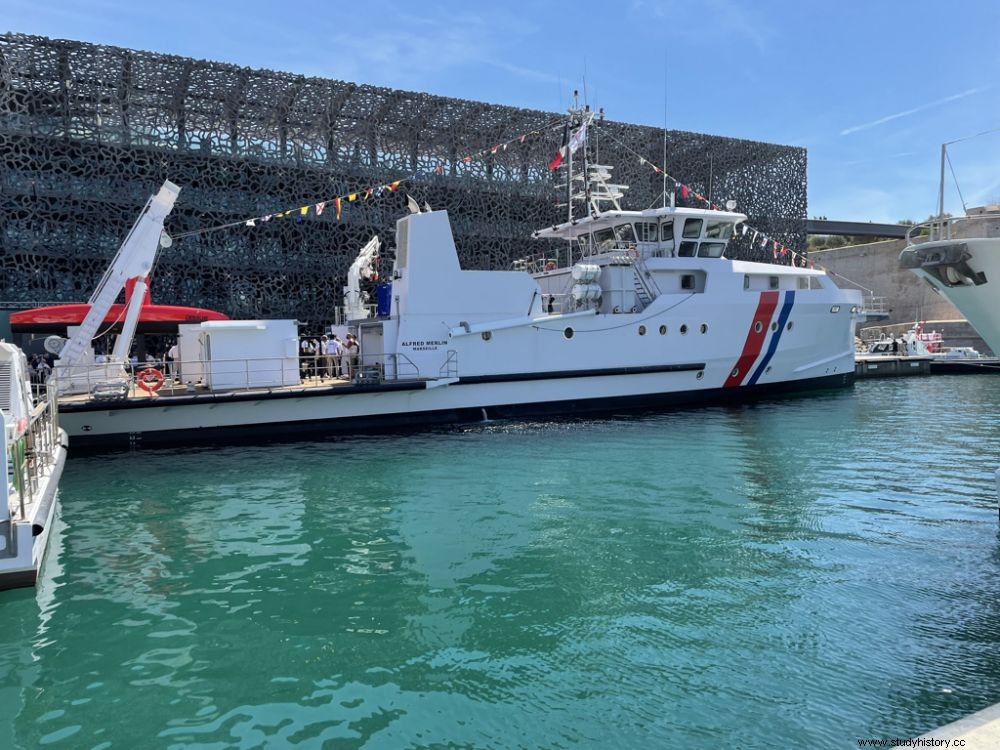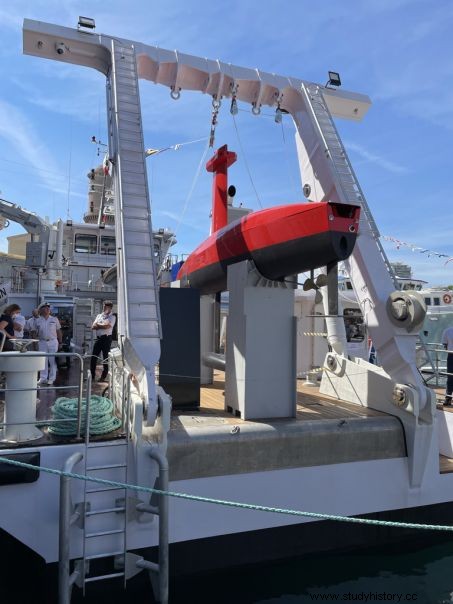Baptized in Marseille on July 2, 2021, this technology-packed boat will be the third building dedicated to underwater archaeology.

The Alfred Merlin berthed in front of the Mucem in Marseille.
Alfred Merlin (1876-1965) was a historian and archaeologist who, as director of the antiquities service in Tunisia, organized the first underwater archaeological excavation in history, in 1907, on the Wreck of Mahdia. A site that houses a Greek ship that sank in the 1st century BC and inside which divers have found a huge variety of works of art and construction materials, most of them on display at the Bardo Museum in Tunisia. It is to pay tribute to this pioneer of underwater archeology that the DRASSM (Department of Underwater and Underwater Archaeological Research) has decided to name its third ship with his surname. Baptized in Marseille on July 2, 2021 in the presence of the Minister of Culture, Roselyne Bachelot, who becomes her "godmother" and the Minister of the Sea, Annick Girardin, she is ready to take to the sea.
The largest composite shell
For the occasion, the entire DRASSM fleet, the Triton and the André Malraux, were present to welcome the newcomer. 46 meters long and 10.80 meters wide, the Alfred Merlin is the largest of the three. It was designed by the Mauric firm in Marseille and built by the iXblue shipyard in La Ciotat, not far from Marseille. It is intended for the high seas and will thus make it possible to explore the French maritime public domain and its 11 million square kilometers, DOM and TOM included.
Alfred Merlin (1876-1965) was a historian and archaeologist who, as director of the antiquities service in Tunisia, organized the first underwater archaeological excavation in history, in 1907, on the Wreck of Mahdia. A site that houses a Greek ship that sank in the 1 st century before our era and within which divers have found a very wide variety of works of art and construction materials, most of them exhibited at the Bardo Museum in Tunis. It is to pay tribute to this pioneer of underwater archeology that the DRASSM (Department of Underwater and Underwater Archaeological Research) has decided to name its third ship with his surname. Baptized in Marseille on July 2, 2021 in the presence of the Minister of Culture, Roselyne Bachelot, who becomes her "godmother" and the Minister of the Sea, Annick Girardin, she is ready to take to the sea.
The largest composite shell
For the occasion, the entire DRASSM fleet, the Triton and the André Malraux, were present to welcome the newcomer. 46 meters long and 10.80 meters wide, the Alfred Merlin is the largest of the three. It was designed by the Mauric firm in Marseille and built by the iXblue shipyard in La Ciotat, not far from Marseille. It is intended for the high seas and will thus make it possible to explore the French maritime public domain and its 11 million square kilometers, DOM and TOM included. This ship is full of new technologies and innovations, but the most striking is undoubtedly its hull entirely built of composite materials from recycled fibers:it is the largest hull of its kind. 60% lighter than steel structures, it was chosen for its low environmental impact. With it, in fact, there is no longer any need for anti-corrosion paints and the sperm whales will sleep more peacefully below because the vessel's underwater acoustic signature is also reduced. As well as fuel consumption.
As this is a prototype ship whose technologies used for its construction will be exported and reused by other shipyards, the hull of the Alfred Merlin also houses a set of deformation sensors, called Bragg grating. They will make it possible to better understand the constraints it will endure and the behavior of the boat at sea. Still on the material side, the gantry at the rear intended to launch automated equipment such as the DriX surface drone (photo below ) is constructed from 100% carbon. Another first!

Alfred Merlin carbon gantry with DriX . Credits:J.I.
Moreover, despite its light weight, the Alfred Merlin was designed to allow the 22 scientists (maximum and rather 20 during long trips) to work in the best conditions. Also, particular attention has been paid to stability at low speeds and even when stationary. It is the first scientific vessel to have a semi-SWATH profile (Small Waterplane Area Twin Hull), a principle usually reserved for catamarans and which makes it possible to attenuate the movements of the swell.
Artificial Intelligence
The Alfred Merlin will also benefit from artificial intelligence to navigate thanks to two solutions developed by iXblue. The first, Cetos e-vision, makes it possible to retrieve all external data relating to the navigation area such as the position of lighthouses or buoys and to project them in 3D on augmented reality screens. The other part, Cetos e-positioning, will give the very precise position of the ship by collating the results of all the navigation sensors including GPS, radar or sonar and measurements from the inertial unit. A device that integrates the various movements of the boat and its speed to determine its position.
Twitch replay of April 15, 2021 on underwater wrecks with Jean-Bernard Memet expert in marine corrosion .
After its baptism and from this summer, the Alfred Merlin will be at sea and for its first mission, it will be responsible for supporting an international team which must carry out an exploration campaign, under the aegis of Unesco, of the "Shoals of Skerki". A site located in international waters, between Italy and Tunisia, which houses, at a depth of 200 meters, the wrecks of five Roman ships dating from a period between the 1st century BC and the 4th century after J. - C. It is also the place of a great naval battle which took place in 1942 between the fleets of Great Britain and those of the axis. After this Mediterranean stage, the Alfred Merlin will head for the colder waters of Saint-Pierre-et-Miquelon.
